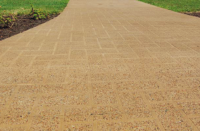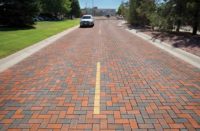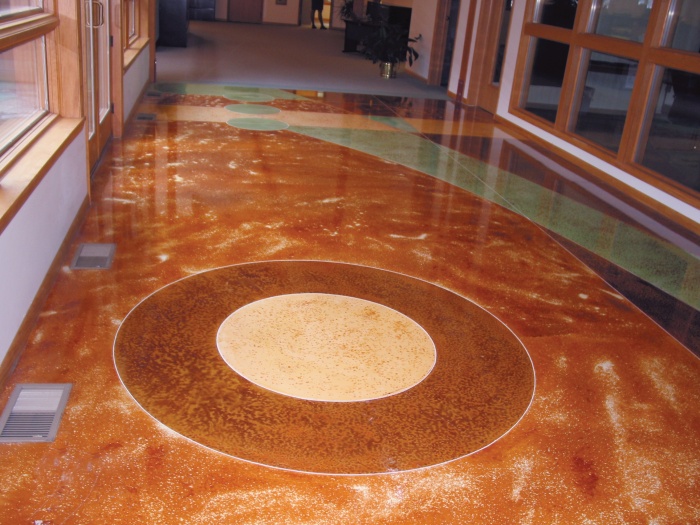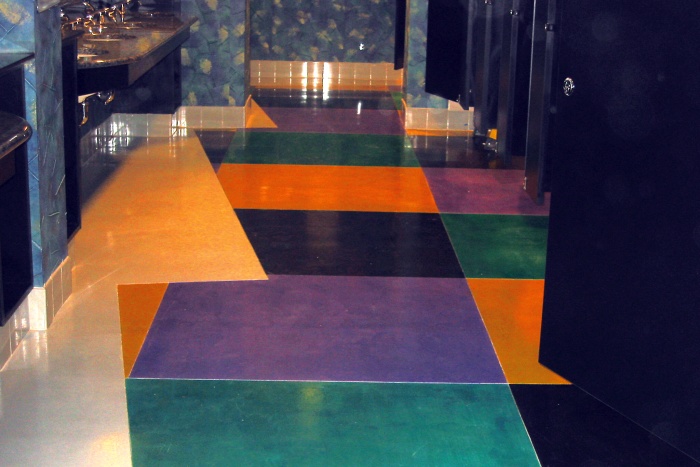The use of polymer-modified cement products in the decorative concrete industry is common practice. Unfortunately, these products are also commonly misunderstood. What they are, how they work, what they do — “There are a lot of misconceptions about polymers,” observes Stan Stratton, director of technology development at L.M. Scofield’s West Coast production location in Los Angeles.
And as Ronald Borum, executive vice president of Crossfield Products in Rancho Dominguez, Calif., points out, “You have to buy the right tool for the right job.”
What are polymers?
You don’t have to be a chemist to understand the basics. “Polymer” is a very generic term that refers to a chain of simple monomer molecules. If the monomers in the chain are the same it is a homopolymer. If the monomers are different you have a copolymer. When polymer particles are dispersed in water you have what is generally called a latex.
Natural rubber latex is an organic polymer. D. Gerry Walters, a 46-year veteran in the industry and now a consultant based in Pine Knoll Shores, N.C., explains that synthetic polymers didn’t start to appear until the early 20th century. While there are all kinds of latexes commercially available today, most of them are not appropriate for use with hydraulic cements.
The polymers most frequently used with hydraulic cements include: styrene-butadiene rubber (SBR); styrene-acrylic; ethylene vinyl acetate (EVA; also called VAE); vinyl acetate homopolymers (PVA); and vinyl ester of versatic acid (VEOVA).
When polymers are added to concrete or cement mortar, the object is to have the polymer particles evenly dispersed throughout the mix in an appropriate ratio, so that, as the mixture cures, the polymers coalesce and form a co-matrix within the structure of the polymer-modified concrete or mortar.
Polymers enhance portland cement-based products
Polymers are used for two primary reasons: good adhesion and water-resistance, explains Walters.
They also help cement-based products adhere to non-cementitious substrates, such as wood, observes Dan Cook, president of A.W. Cook Cement Products in Atlanta. But don’t equate adhesion with bond strength — they are not the same.
Other characteristics include “added flexural and tensile strength, [and] improved abrasion-resistance,” reports Matt Casto, vice president of technical services of Bomanite Corp. in Madera, Calif. What polymers don’t add, he says, is compression strength.
Stratton echoes that observation. “Polymers soften the cementitious matrix. Instead of resisting load, it gives a little bit, which [helps] eliminate cracking and reduces brittleness. On a bridge deck that’s an important property.”
And, while pour thickness is generally dependent on the size of the aggregate, polymers help enable very thin applications — as thin as one-sixteenth of an inch.
Each kind of polymer has individual properties, however, so it is important to select the right polymer for the project. Contractors should know the basic parameters of the products they use. What is adhesion? What is tensile strength? What do these properties mean? This information is usually listed on the product’s data sheets
The differences between polymers can mean success or utter failure.
“SBR is probably the best for adhesion and water resistance, but, if color is important, [you need to know] it will discolor in ultraviolet light,” observes Walters. “For adhesion, water resistance and color stability, go to an acrylic.” For good adhesion and good color when water resistance is not as critical — such as in an indoor or dry application — a VAE can be used, he says.
You’ll find polymers in a wide variety of decorative and repair products — self-leveling formulations; stampable, thick-section overlays and repair mortars; and micro-toppings. “The best polymer cements are the ones that have hybrid polymers,” says Casto. “Blends are better because you have the best of all worlds.”
Polymers come wet or dry
Polymers are available in liquid and dry powder. Polymers are spray-dried to obtain the powdered form. “You can formulate a dry blend or use a liquid to get the same benefits,” Cook says.
One advantage of liquid polymers is that they “can be supplied in different concentrations, which can be diluted on the job site,” observes Cook. More-polymer-in-less-space, as far as transportation and storage considerations go. But “liquid polymers can’t stand freeze and thaw cycles; they render the polymer inactive,” he says.
Borum says that, over time, liquid formulations can also settle, but if stored in sealed containers they can be reworked.
In powdered form, polymers are usually already incorporated into the dry cement mix product and packed in bags. Out in the field, all you have to do is add water.
“Powders are not affected by freezing temperatures,” reports Seth Pevarnik, technical field consultant for Ardex in Aliquippa, Pa. While cold temperatures won’t hurt dry polymers, he says it’s a good idea to let the product warm up a bit before using. “If the powders are very cold, they won’t work the same way as normal and may not flow.”
While dry powder polymer formulations are easy to store, they are subject to moisture.
In hot weather, another consideration is how quickly dry and liquid polymer products can be cooled for use. Borum says with powders you might need to use cool water in the mix or let them acclimate over time, whereas with liquid polymers you can set the container in a cool water bath or chilled room. “It’s a minor detail, but something someone should consider, especially in the Sunbelt.”
The proper ratios are critical
Not only is the type of polymer important but the amount is, as well, explains Cook. “When you engineer a topping, overlay, decorative or repair product, you’re concerned with the polymer-cement ratio to achieve the characteristics you want.” Too little, or too much, can be detrimental. If it’s too sticky to trowel, the product will be too hard to work. If it’s too flexible, you’ll have lower compressive strength and less wearability, he says.
You need the proper density of polymer for good hydration and cross-linking. If the ratio is watered down (such as by adding too much water to the mix or overloading integral color) the physical characteristics of the polymers will be affected.
“It’s important to strictly adhere to the liquid dosages specified by the manufacturer, whether it’s for a liquid polymer or pre-blended polymer product,” Cook cautions.
If conditions in the field call for mix modification, check with the manufacturer for recommendations so the final product is not compromised. Typically, however, admixtures that are used with cement-based products can be used with polymer-modified products (though pre-blended dry polymer products are considered already “engineered”).
In this vein, the polymer industry is continuing to make advances in technology to incorporate additional traits to the polymer chains to address other mix issues. There are “new polymers that have grafted functional materials on the polymers,” reports Stratton. “They have a polymer backbone and function as a polymer, but have added functional groups of pendant chains — polymers with plasticizers, with accelerators, with defoamers, with hydrophobic agents.”
Tips for working with polymer-modified products
All the rules of traditional concrete apply to polymer-modified concrete. Moving and control joints need to be honored, active cracks need to be corrected, and appropriate site preparation — including substrate priming, if required — needs to be done. But polymer-modified products are not the same as traditional cement-based products — a little extra finesse is required.
“I think polymer-modified cement toppings require a different level of technique than standard concrete work,” advises Mark Donaldson, director of operations for Skookum Floors USA in Seattle. These products “require you to get it right the first time. Repairs are difficult to hide or blend in.”
Walters says you need to get off on the right foot. “From an application standpoint for PMC (polymer-modified cements), the substrate needs to be damp. If you put your hand down, you should feel moisture, but no standing water.”
To use polymer-modified products you normally need the temperature to be above 45 degrees Fahrenheit and no more than 85 degrees. But, as Walters points out, that’s really a requirement of the cement rather than the polymer; though temperature does affect how quickly the surface of a polymer-based product skins.
You have to work quickly. Polymer-modified products typically have a short finishing time because they tend to skin over. “You have about 15 minutes to finish it,” Walters says. “High humidity is a good environment to work in because they are typically low-water-to-cement ratios.” Avoid hot sunny days, he says. “Early morning under heavy mist is best.” However, using water on the surface is not a good idea because it will weaken it, Stratton adds.
The finish technique you use will depend on the product; for example, is it self-leveling or trowelable? Once you have a good finish, stop! You don’t have a lot of time to fuss or you’ll mar the skin as it develops.
When you’re done with the finish, Walters says, “You need to cover it to prevent water loss … so the surface film cures correctly. If the surface dries too fast, you get plastic shrinkage cracking — not harmful, but very unsightly, like wrinkles on someone’s face.” Keep the cover on for 24 hours, he recommends, then remove it and let the product harden as fast as possible.
Speed is definitely a plus with these products. Donaldson explains, “As a time-frame issue, [traditional concrete] needs 28 days for a full cure before decoration. Topping systems can be turned around in three-to-four days — complete!”
Donaldson’s experience is that polymer-modified products are generally designed to accept various color systems out on the market, but he recommends “in-house testing to make sure the coloring and sealers are compatible.”
When it comes to cost, polymer-modified products are more expensive than traditional cement-based products, but there can be valuable cost savings in increased lifecycle, reduced maintenance costs, and the time and labor required for a job.
Don’t reinvent the wheel
“There are so many variables, a lot comes down to experience,” remarks Donaldson. You may have to try different products out in different situations, but “it’s hard to learn the variables of all the products.”
That’s where manufacturer training and technical advice come in.
“This is the fastest-growing section of the decorative concrete industry,” says Casto. “There are a lot of players in the market. If [contractors] go to companies that have technical expertise … you’ll have a better product.”
“Training helps contractors become familiar with the products. Look for in-the-field as well as formal seminar training [at the factory],” recommends Pevarnik. “I’d want to be as educated as the manufacturer on the materials.”
Different products, different characteristics, different applications. As Stratton aptly observes, “a polymer isn’t just a polymer.” Contractors experienced with polymer-modified products say they are exciting; that they expand the possibilities, options and opportunities for decorative concrete. As the technologies continue to evolve, there are new experiences ahead for the whole industry. Just remember: Pick the right polymer for the application.

















